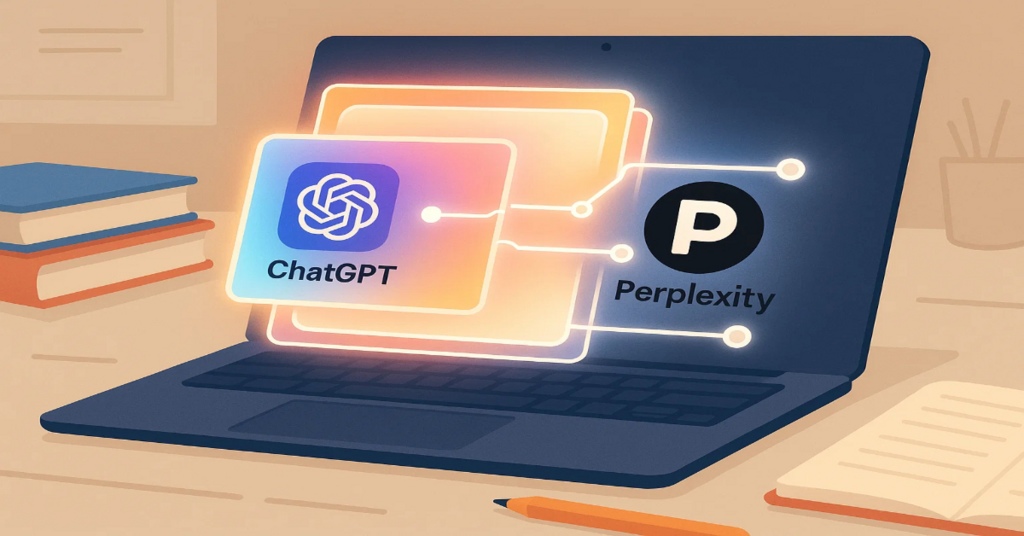Why ChatGPT and Perplexity Became the Real Study Hack for Students
ChatGPT is no longer just Artificial Intelligence Software. Paired with Perplexity AI, it has become the shortcut students in the US use to turn endless lecture notes into flashcards and cited summaries that cut hours of cramming.
Claude rewrites the material into a natural Language Model tone, Gemini ChatBot validates deadlines, and DeepSeek helps benchmark against peer-reviewed sources. Instead of scrolling through 40 pages of notes the night before an exam, students now rely on prompt generators that deliver structured, citation-backed flashcards in minutes.
The Student Who Finally Escaped Cramming
Elena, a second-year biology student, had a problem. She would re-read entire notebooks before exams, burn out, and still forget details. On a friend’s advice, she tested ChatGPT with a simple prompt:
Context: 30 pages of lecture notes.
Task: Summarize into 25 flashcards.
Format: Q (front), A (back), Source.
Constraint: Cite textbook page or lecture date.
ChatGPT structured the cards instantly. Perplexity validated the citations. Claude smoothed the answers into clear sentences. Elena imported them into Anki. What once took her a full weekend now took less than an hour.
Prompt #1: Lecture Notes → Flashcards
Summarize lecture notes into 20 flashcards.
Output: Table (Question, Answer, Citation).
Constraint: Limit answer to 20 words.
Claude humanizes tone. Perplexity ensures sources are valid.
Prompt #2: Textbook → Study Pack
Convert chapter into:
– 10 key ideas
– 5 practice questions
– 1 essay outline
Gemini checks alignment with syllabus. DeepSeek benchmarks references.
Prompt #3: Group Project → Mini Exam Deck
Extract 15 flashcards from group project notes.
Include citations.
Format: Table (Q, A, Source).
Claude rewrites conversationally.
What Changed for Elena
By finals, Elena wasn’t cramming at 3 a.m. She studied flashcards daily in 15-minute blocks. Her GPA rose from 2.9 to 3.5, and her stress dropped sharply.
Old vs New Workflow
| Workflow | Old Way | ChatGPT + Perplexity |
| Notes | Typed, unorganized | Summarized + cited |
| Flashcards | Made manually, hours wasted | Automated in minutes |
| Sources | Rarely checked | Verified citations |
| Exam prep | Last-minute cramming | Daily flash review |
| Sleep | 4–5 hours/night | 7+ hours |
Chatronix: The Multi-Model Shortcut
Elena soon realized switching between ChatGPT, Claude, Perplexity, and Gemini was slowing her down. That’s when she tried Chatronix.
Inside one workspace she found:
- 6 best models in one chat: ChatGPT, Claude, Gemini, Grok, Perplexity AI, DeepSeek.
- 10 free queries to test flashcard prompts.
- Turbo mode with One Perfect Answer — merges six outputs into one polished summary.
- Side-by-side comparisons to pick the clearest set of cards.
And since September, there’s a bonus:
The Back2School campaign makes the first month Pro plan just $12.5 instead of $25 — cheaper than a single workbook.
Prompt Library Inside Chatronix
The Prompt Library was the breakthrough. With ready-made stacks for education, marketing, SMM, copywriting, business, Elena no longer started from scratch. She borrowed frameworks like “Lecture → Flashcards” or “Textbook → Exam Pack” and adjusted them in minutes. People say it saves more time than any other tool — especially with tagging and favorites that let you keep the best prompts on hand without rewriting them.
Bonus Prompt for Students
Here’s the exact workflow Elena now runs weekly:
Context: Preparing for midterm in biology.
Task: Turn lecture notes + textbook into:
1. 30 flashcards with citations.
2. 5 practice questions.
3. 1 essay outline.
Workflow:
– ChatGPT: Build flashcards.
– Claude: Rewrite in plain tone.
– Perplexity: Validate citations.
– Gemini: Align with syllabus deadlines.
– DeepSeek: Benchmark against peer-reviewed material.
Output: Table of flashcards + summary doc.
<blockquote class=”twitter-tweet”><p lang=”en” dir=”ltr”>Steal this chatgpt cheatsheet for free😍<br><br>It’s time to grow with FREE stuff! <a href=”https://t.co/GfcRNryF7u”>pic.twitter.com/GfcRNryF7u</a></p>— Mohini Goyal (@Mohiniuni) <a href=”https://twitter.com/Mohiniuni/status/1960655371275788726?ref_src=twsrc%5Etfw”>August 27, 2025</a></blockquote> <script async src=”https://platform.twitter.com/widgets.js” charset=”utf-8″></script>
What Elena learned — and what many US students now confirm — is that flashcards from ChatGPT and Perplexity only work if they’re part of a realistic routine. AI-generated cards are fast, but discipline comes from structure:
- Morning review: 10 cards over coffee — no scrolling, just focused recall.
- Afternoon reset: 15 cards between classes — shorter bursts improve memory retention.
- Pre-exam evening: 30–40 cards maximum — structured review beats chaotic cramming.
The biggest shift wasn’t just automation. It was consistency. Instead of binging material before an exam, students layered short study blocks daily. By combining flashcards, cited summaries, and weekly resets in Notion or Anki, they cut study time by half while raising GPA.
Final Takeaway
For students, the edge isn’t grinding harder — it’s structuring smarter. ChatGPT builds the cards, Perplexity validates sources, Claude makes them human, and Chatronix merges everything.
⚡ The result: cited summaries, consistent flashcards, zero cramming. And yes — it works.






